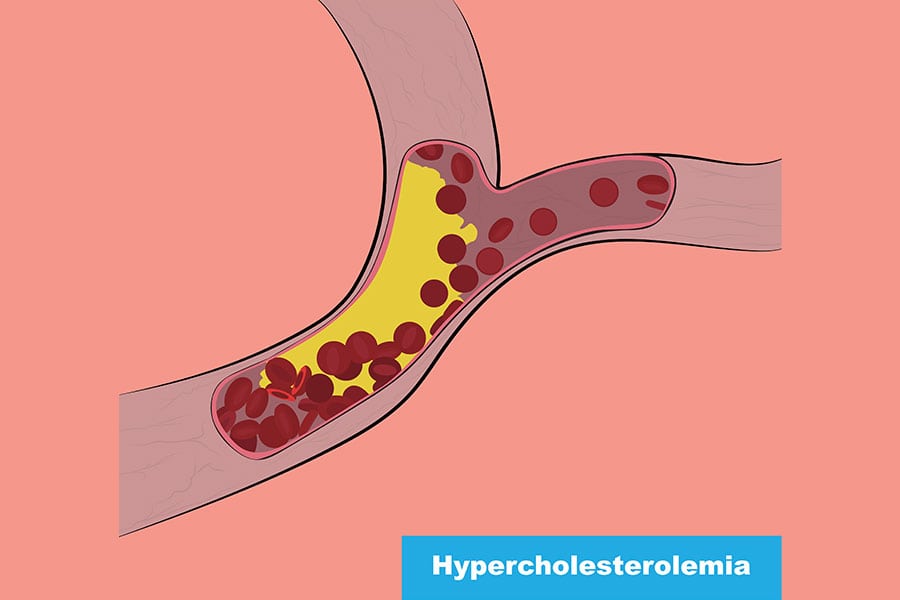Familial Hypercholesterolemia (FH) is a genetic disorder characterized by elevated levels of low-density lipoprotein cholesterol (LDL-C) in the blood. This high cholesterol can lead to premature cardiovascular diseases, such as heart attacks and strokes.
Overview
As one of the most common inherited genetic disorders affecting heart health, FH has a prevalence that might surprise many: 1 in 250 individuals globally. Despite being common, it remains underdiagnosed. FH results from mutations in genes that play roles in the metabolism of LDL-C, leading to its accumulation in the bloodstream.
Symptoms
While high cholesterol itself doesn’t cause overt symptoms, certain indicators related to complications of FH include:
- Xanthomas: These are fatty deposits that can appear as bumps or lumps under the skin, typically around the elbows, knees, or hands.
- Xanthelasmas: Yellowish patches or lumps around the eyes.
- Corneal arcus: A gray or white arc visible on the outer part of the cornea of the eye.
- Chest pain or angina: This occurs due to the buildup of cholesterol in arteries supplying the heart.
Causes
FH is primarily caused by mutations in one of three genes:
- LDLR: This gene provides instructions for making a protein that helps remove LDL cholesterol from the bloodstream.
- ApoB: A mutation here affects the protein’s ability to bind with the LDL receptor, leading to less cholesterol being removed.
- PCSK9: Mutations can increase the amount of LDL cholesterol in the blood.
Risk Factors
While the primary risk factor for FH is a family history of the disorder, other factors can exacerbate its effects:
- Diet high in saturated fats and cholesterol: This can further elevate cholesterol levels in FH patients.
- Obesity: Excess weight contributes to higher LDL-C levels.
- Smoking: It damages blood vessels and reduces the ability of the body to transport cholesterol effectively.
- Diabetes: High blood sugar contributes to higher LDL-C and lower HDL cholesterol levels.
- Alcohol Consumption: Excessive alcohol use can raise cholesterol levels.
Prevention and Management
- Healthy Diet: Consuming a diet low in saturated fats, trans fats, and cholesterol can help manage cholesterol levels. Including omega-3 fatty acids, found in fish, can also be beneficial.
- Regular Exercise: Physical activity raises high-density lipoprotein (HDL) cholesterol, the “good” cholesterol, while decreasing LDL.
- Medications: Statins are the primary drugs used to treat FH. They lower LDL cholesterol by slowing its production in the liver.
- LDL Apheresis: This procedure physically removes LDL cholesterol from the blood, somewhat like dialysis.
When to see a doctor
- Family History: If there’s a history of early heart disease or high cholesterol in the family.
- Physical Symptoms: Presence of xanthomas, xanthelasmas, or signs of coronary artery disease.
- Routine Check-ups: It’s advisable for adults over 20 to have their cholesterol checked every five years.
Additional Insights
- Pregnancy Considerations: Women with FH should consult their doctors when planning for pregnancy. Some cholesterol-lowering medications are not safe during pregnancy.
- Childhood Diagnosis: Children with a family history of FH should have their first cholesterol test between ages 2 and 10.
- Support Groups: Connecting with others facing the same challenges can provide both emotional support and practical insights.
Types of Familial Hypercholesterolemia
There are two types of FH based on inheritance patterns:
- Heterozygous FH (HeFH): This is more common, where an individual inherits one mutated gene from one parent. HeFH affects 1 in 250 to 500 people globally.
- Homozygous FH (HoFH): This is rarer and more severe. An individual with HoFH inherits two mutated genes (one from each parent). It affects about 1 in 160,000 to 300,000 people.
Genetic Testing
Due to the inheritable nature of FH, genetic testing can be a crucial tool for early diagnosis. It involves analyzing DNA to look for mutations associated with the disorder. It’s especially valuable when there’s a known family history of FH.
Impact on Life Expectancy
Individuals with untreated FH have a much higher risk of premature heart disease. Men with FH have a 50% risk of a heart attack by the age of 50, and women have a 30% risk by age 60. However, early detection and treatment can normalize life expectancy.
Role of Diet
While FH is genetic, diet plays a crucial role in managing the condition. Trans fats, often found in processed foods, can raise LDL cholesterol levels, while foods rich in soluble fiber, like oats and beans, can lower it.
Emerging Therapies
Apart from statins, new drug therapies like PCSK9 inhibitors and Bempedoic acid are showing promise in lowering LDL cholesterol levels for individuals with FH.
Living with FH
Lifestyle adaptations, including regular check-ups, monitoring cholesterol levels, maintaining a heart-healthy diet, and exercising regularly, can greatly improve the quality of life.
Children and FH
It’s recommended that children with one parent having FH get tested by age 2. This is because they have a 50% chance of inheriting the condition. Early diagnosis allows for lifestyle modifications from a young age, which can be particularly effective.
Cost Implications
Managing FH can have financial implications. The cost of medications, LDL apheresis, and regular check-ups can add up. It’s essential to discuss with healthcare providers about potential assistance or insurance coverage options.
Psychological Impact: A diagnosis of FH can bring about anxiety and stress. Concerns about the implications for one’s health, longevity, and the possibility of passing on the condition to offspring can weigh heavily. Seeking support, both professionally and through patient communities, can be helpful.
Research and Future Prospects: There’s ongoing research on understanding FH better and developing newer, more effective treatments. As science progresses, the future looks promising for even more effective management and potential treatments for FH.
In Conclusion, Familial Hypercholesterolemia is more than just a genetic anomaly; it’s a significant health challenge that, when not addressed, can lead to severe complications. However, with early diagnosis, a holistic approach to management, and the armament of knowledge, those with FH can lead a fulfilling, healthy life.
Awareness is key, and knowledge truly can save lives. Whether you’re living with FH or know someone who is, taking the time to understand and address this condition is a step toward a healthier heart and a brighter future.









